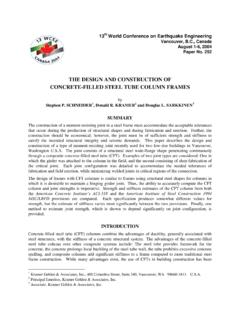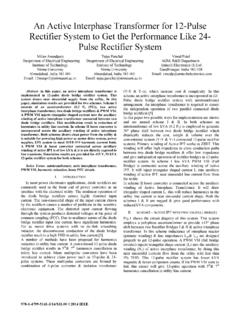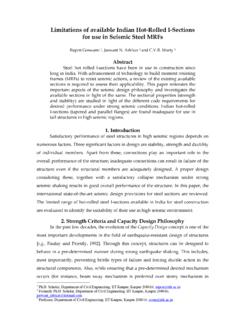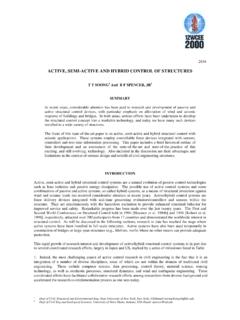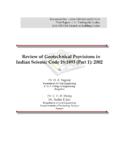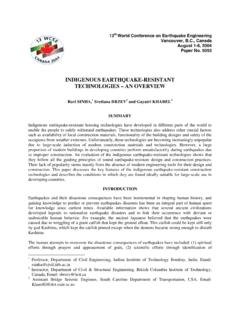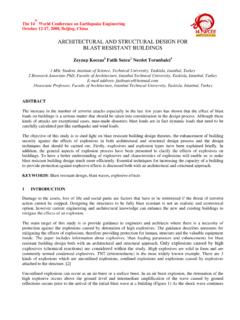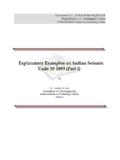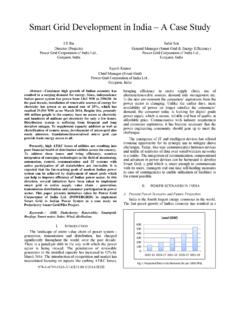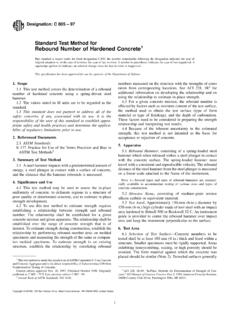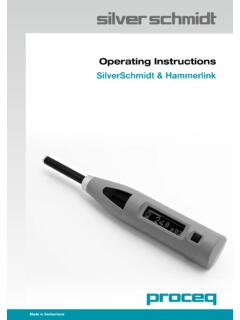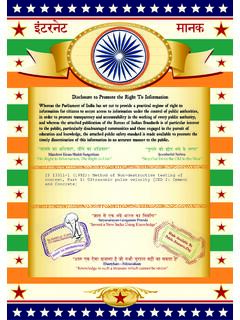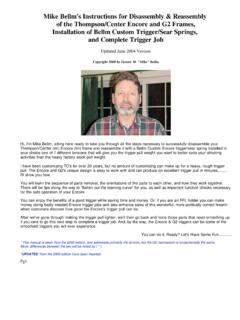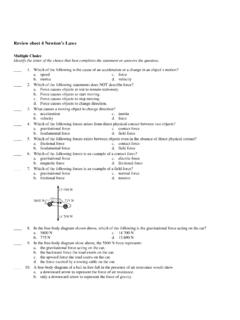Transcription of IS 13311-2 (1992): Method of non-destructive testing of ...
1 Disclosure to Promote the Right To InformationWhereas the Parliament of India has set out to provide a practical regime of right to information for citizens to secure access to information under the control of public authorities, in order to promote transparency and accountability in the working of every public authority, and whereas the attached publication of the Bureau of Indian Standards is of particular interest to the public, particularly disadvantaged communities and those engaged in the pursuit of education and knowledge, the attached public safety standard is made available to promote the timely dissemination of this information in an accurate manner to the public. ! $ ' + - Satyanarayan Gangaram Pitroda Invent a New India Using Knowledge 0 1 ' 5 Jawaharlal Nehru Step Out From the Old to the New 1 + , 1 + Mazdoor Kisan Shakti Sangathan The Right to Information, The Right to Live ! > 0 B Bhart hari N ti atakam Knowledge is such a treasure which cannot be stolen Invent a New India Using Knowledge IS 13311-2 (1992): Method of non-destructive testing ofconcret-methods of test, Part 2: rebound hammer [CED 2:Cement and Concrete]Indian Standard NON-DESTRUCTWETESTINGOF CONCRETE-METHODSOFTEST PART 2 rebound hammer ( First Reprint JUNE 1995) tJDC : 620*179*1 Q BIS 1992 BUREAU OF INDIAN STANDARDS MqNAK BHAVAN, 9 BAHADUR SHAH ZAFAR MARG NEW DELHI 110002 April 1992 Price Groop 3 Cement and Concrete Sectional Committee, CED 2 FOREWORD This Indian Standard was adopted by the Rureau of Indian Standards, after the draft finalized by the Cement and Coacrete Sectional Committee bad b een approved bg&+fivil Engineering Division Council.
2 There are occasions when the various perfortiance characteristics of concrete in a structure are required to be assessed. In most of the cases, an estimate of strength of concrete in the structure is needed, although parameters like overall quality, uniformity, etc, also become important in others. The various methods that can be adopted for in-situ assessnhent of strength properties of concrete depend upon the particular aspect of strength in question. For example, if the load-carrying capacity of structural ensemble is to be assessed, carrying out a full-scale load test 8s per IS 456 : 1978 Code of practice for plain and reinforced concrete ( third revision ) or IS 1343 : 1980 Code of practice for prestressed concrete (first revision ) is the most direct way; on the other hand when the actual com- pressive strength of a concrete in the structure is to be measured, core testing as per IS 516 : 1959 & Method of test for strength of concrete is more reliable. However, both these methods are relatively cumbersome and the latter Method may leave the structure damaged locally in some cases, Use is, therefore, made of suitable non-destructive tests, which not only provide an estimate of the relative strength and overall quality of concrete in the structures, but also help in deciding whether more rigorous tests like load testing or core drilling at selected locations are required.
3 There a re various such non-destructive testing methods which can be broadly classified as those which measure the overall quality of concrete, for example dynamic or vibration methods like resonance frequency and ultrasonic pulse velocity tests; and those which involve measurement of parameters like surface hardness, rebound , penetration, pull-out strength, etc, and are believed to be indirectly related to the compressive strength of concrete. In addition, radiographic, radiometric, nuclear, magnetic and electrical methods are also available. Since such non-destructive tests are at best indirect methods of monitoring the particular characteristic of concrete and the measurements are influenced by materials, mix and environmental factors, proper interpretation of the results calls for ce1 tain degree of expertise. It is more so, when the data on the materials and mix proportions used in the construc- tion are not available as is often the case. In view of the limitations of the Method for predicting the strength of concrete in the structure, it is preferable that both ultrasonic pulse velocity given in Part 1 of the standard and rebound hammer Method are used in combination to alleviate the errors arising out of influence of material, mix and environmental parameters on the respective measurements.
4 Relationships between pulse velocity, rebound number and compressive strength of concrete are obtained by multiple regression of the measured values on laboratory test specimens. However, this approach has the limitation that the correlations are valid only for the materials and mix proportions used in the trials. The intrinsic difference between the laboratory test specimens and in-situ concrete, for example surface texture, moisture condition, presence of reinforcement, etc, also affect the accuracy of results. The correlation is valid only within the range of values of pulse velocity, rebound number and compressive strength employed and any extrapolation beyond these is open to question. The rebound hammer test is not intended as a substitute for standard compression test, but as a Method for determining the uniformity of concrete in the structure and comparing one concrete with another. Because of the above limitations, the combined use of these two methods is made in another way.
5 In this, if the quality of concrete is assessed to be excellent or good by pulse velocity Method , only then the compressive strength is assessed from the rebound hammer indices, and this is taken as indicative of strength of concrete in the entire cross-section of the concrete member. When the quality assessed is medium , the estimation of compressive strength by rebound indices is extended to the entire mass only on the basis of other colateral measurements, for example, strength of site concrete cubes, cement content in the concrete or core testing . When the quality of concrete is doubtful, no assessment of concrete strength is made from rebound indices. In most of the situations, the records ?f the original materials or mix proportions used in the strut_ / ture are not available. Therefore, cqnslderable improvisation has to be done in evolving the testing scheme and use is made of comparafive measurements made on adjoining portions of the structures or even other structures in the vicmlty of the one in question.
6 In doing so, an approach is taken t the same materials and similar mix proportions and level of workmanship were employed for the t at hw, ( Contitzued on \ third cover ) Is 13311( Part 2 ) : 1992 Indian Standard non-destructive testing OF CONCRETE-METHODSOFTEST PART 2 rebound hammer 1 SCOPE This standard covers the object, principle, apparatus and procedure of rebound hammer test Method . In addition, influence of test conditions and some general guidance on the interpretation of test results are also given. NOTE - In view of the limitations of each Method of non-destructive testing of concrete, it is essential that the results of tests obtained by one Method .should be complimented by other tests and each Method should be adopted very carefully. 2 REFERENCES rebound is read off along a graduated scale and is designated as the rebound number or rebound index. 4 APPARATUS The rebound hammer It consists of a spring controlled mass that slides on a plunger within a tubular housing.
7 The impact energy required for rebound hammers for different applications is given in Table 1. The following Indi an standards are necessary adjuncts to this standard. IS No. Title 516 : 1959 Method of test for strength of concrete Table 1 Impact Energy for rebound Hammers for Different Applications ( Clause ) Sl No. Application Approximate Impact Energy Required 8900 : 1978 Criteria for rejection of outlying observations 3 OBJECT AND PRINCIPLE OF TAXST Object The rebound hammer Method could be used for: i) ii) iii) i) assessing the likely compressive strength of concrete with the help of suitable co- relations between rebound index and compressive strength, for th Reiound Hammers ( Nm 1 For testing normal weight 2 25 concrete For light-weight concrete or 0 75 small and impact sensitive parts of concrete For testing mass concrete, 30 00 for example in roads, air- fields pavements and hydrau- lic structures 5 CMJXKING OF APPARATUS ii) assessing the uniformity of concrete, iii) assessing the quality of the concrete in relation to standard requirements, and iv) assessing the quality of one element of concrete in relation to another.
8 NOTE - The rebound hammer Method can be used with greater confidence for differentiating between the questionable and acceptable parts of a structure or for relative comparison between two different structures. Principle of Test It is necessary that the rebound hammer is checked against the testing anvil before com- mencement of a test to ensure reliable results. The testing anvil should be of steel having Brine11 hardness of about 5 000 N/mms. The supplier/manufacturer of the rebound hammer should indicate the range of readings on the anvil suitable for diRerent types of rebound hammers. Procedure of Obtaioing Correlation Betaeeu Compressive Strength of Concrete and rebound Number When the plunger of rebound hammer is pressed against the surface of the concrete, the spring- The most satisfactory way of establishing a controlled mass rebounds and the extent of correlation between compressive strength of concrete and its rebound number is to measure such rebound depends upon the surface hard- ness of concrete.
9 The surface hardness and both the properties simultaneously on concrete therefore the rebound is taken to be related to cubes. The concrete cube specimens are held in a compression testing machine under a fixed the compressive strength of the concrete. The load, measurements of rebound number taken 1 IS 13311( Part 2 ) : 1992 and then the compressive strength determined as per IS 516 : 1959. The fixed load required is of the order of 7 N/mm8 when the impact energy of the hammer is about Nm. The load should be increased for calibrating rebound hammers of greater impact energy and decreas- ed for calibrating rebound hammers of lesser impact energy. The test specimens should be as large a mass as possible in order to minimise the size effect on the test result of a full scale structure. 150 mm cube specimens are preferred for calibrating rebound hammers of lower impact energy ( Nm ), whereas for rebound hammers of higher impact energy, for example 30 Nm, the test cubes should not be smaller than 300 mm.
10 If the specimens are wet cured, they should be removed from wet storage and kept in the laboratory atmosphere for about 24 hours before testing . To obtain a correlation between rebound numbers and strength of wet cured and wet tested cubes, it is necessary to establish a correlation between the strength of wet tested cubes and the strength of dry tested cubes on which rebound readings are taken. A direct correlation between rebound numbers on wet cubes and the strength of wet cubes is not recommended. Only the vertical faces of the cube as cast should be tested. At least nine read- ings should be taken on each of the two vertical faces accessible in the compression testing machine when using the rebound hammers. The points of impact on the specimen must not be nearer an edge than 20 mm and should be not less than 20 mm from each other. The same points must not be impacted more than once. 6 PROCEDURE For testing , smooth, clean and dry surface is to be selected. If loosely adhering scale is present, this should be rubbed of with a grind- ing wheel or stone.

